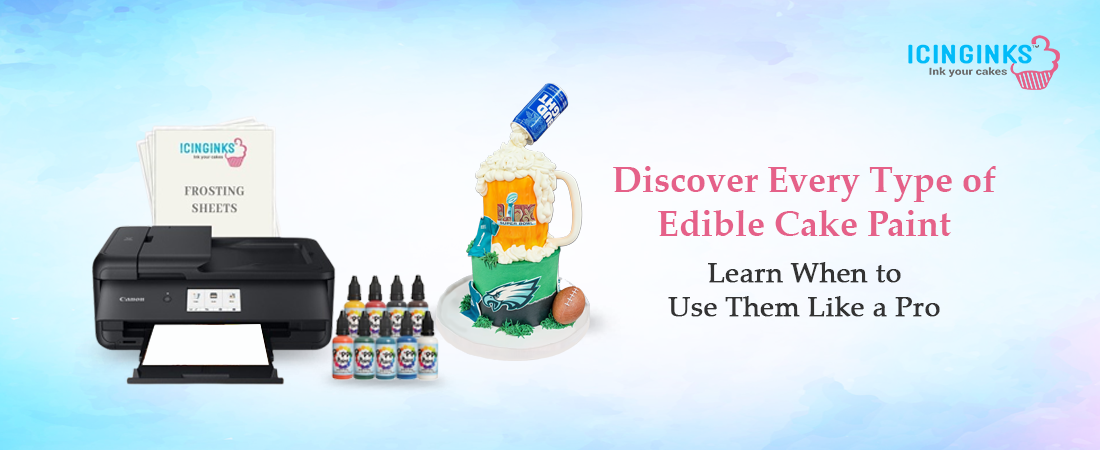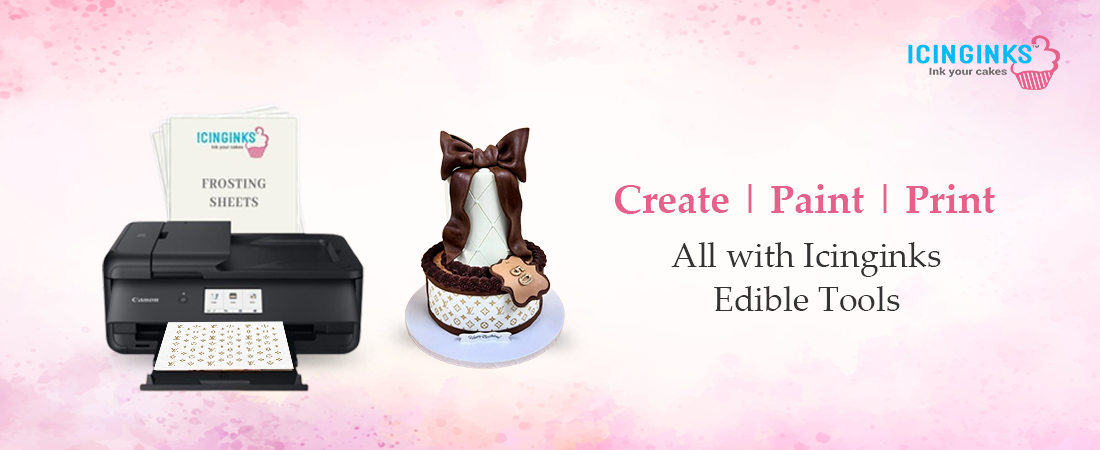
From minimalist watercolor finishes to hyper-detailed illustrations, cake decorating has become an art form in its own right. At the center of this edible artistry is a versatile tool that’s gaining popularity among bakers and confectioners: edible cake paint. Whether you’re a home baker or a professional cake artist, understanding the types of edible paints available and how to use them effectively can significantly elevate your cake designs.
In this blog, we’ll break down the different types of edible cake paint, how each one works, and the best situations for their use. We’ll also explore how these can be used in conjunction with tools like an edible cake printer to create stunning, layered effects.
Why Use Edible Cake Paint?
Before diving into the types, let’s talk about why edible cake paint is a game-changer in cake design.
- Precision & Detail: It allows you to hand-paint fine details directly onto fondant, gum paste, or even cookies.
- Customization: Perfect for creating bespoke designs, monograms, or scenery.
- Visual Depth: You can layer different paint types for dimension and texture.
Unlike traditional frosting techniques or printed designs from an edible cake printer, edible paints offer greater artistic control and a handcrafted finish.
1. Gel-Based Edible Paints
Overview
Gel-based edible paints are made by mixing concentrated food color gel with a small amount of alcohol or a food-grade solvent. This type offers vibrant colors and is commonly used for cake toppers and fondant work.
Best Uses
- Detailing on fondant or gum paste figures
- Painting small accents like flowers or lace patterns
- Adding depth to embossed designs
Pros
- Dries quickly
- Great color payoff
- Easily diluted for watercolor effects
Tip
Use a fine-tipped brush for precision work. These paints dry fast, so blending must be done quickly.
2. Alcohol-Based Edible Paints
Overview
This is the most widely used form of edible cake paint in professional cake decorating. These paints are alcohol-based, which allows for quick drying and improved adhesion on smooth surfaces, such as fondant or royal icing.
Best Uses
- Painting metallic effects (gold, silver, rose gold)
- Creating gradients or ombré effects
- Adding shimmer to sculpted elements
Pros
- Fast drying
- Long-lasting finish
- Great for layering
Tip
Always shake the bottle well before use, especially with metallics, as pigments can settle to the bottom.
3. Water-Based Edible Paints
Overview
Water-based paints are safer for use in households with alcohol restrictions and are ideal for light work. However, they can take longer to dry and may not perform well on non-porous surfaces.
Best Uses
- Coloring porous materials like wafer paper
- Light brushwork on cookies or cakes with a matte finish
- Kid-friendly baking projects
Pros
- Alcohol-free
- Easy cleanup
- Less intense odor
Tip
Avoid using water-based paints on fondant in a humid environment, as they can smudge easily.
4. Powder-Based Edible Paints (Activated with Liquid)
Overview
These dry powders become paint when mixed with a clear alcohol or lemon extract. They’re versatile and easy to store.
Best Uses
- Highlighting details with dry-brushing techniques
- Mixing custom paint colors
- Creating both matte and metallic effects
Pros
- Long shelf life
- Customizable finish
- Multi-purpose: Can be used as dry dust or wet paint
Tip
Start with a few drops of liquid to avoid over-thinning the mixture. You can always add more later.
5. Edible Airbrush Paints
Overview
Although primarily designed for airbrushing, these paints can also be applied with brushes for larger surface areas. They are thin in consistency and provide even, streak-free coverage.
Best Uses
- The base color for cakes
- Background gradients
- Uniform coverage over large fondant surfaces
Pros
- Smooth finish
- Quick to apply
- Available in a wide color range
Tip
While they can be applied with a brush, they work best with an airbrush machine for large projects.
6. Metallic Edible Cake Paints
Overview
Specifically formulated to mimic metals like gold, silver, or copper, these are often alcohol-based and rich in mica particles for shine.
Best Uses
- Luxury cake themes (weddings, anniversaries)
- Accents on toppers or sugar flowers
- Finishing touch on logos and text
Pros
- High impact visual appeal
- Dense pigmentation
- Professional-grade look
Tip
Use a soft brush to avoid streaks, and allow plenty of drying time before adding additional layers.
Combining Edible Cake Paint with Edible Cake Printer Designs
Using an edible cake printer offers the advantage of printing photo-quality images onto frosting sheets or wafer paper. These printed elements can be enhanced with hand-painted details using edible cake paint.
Ideas for Combination
- Paint shadows or highlights over printed characters
- Add metallic or glitter accents to printed borders
- Customize printed logos with brush strokes for depth
This blend of digital precision and hand-painted detail brings a unique artisan quality to your edible creations.
General Tips for Using Edible Cake Paint
- Surface Matters: Paint works best on dry, smooth surfaces, such as fondant, modeling chocolate, or royal icing.
- Brush Quality: Invest in food-safe brushes with soft bristles for better control.
- Drying Time: Allow each layer to dry completely before applying the next to prevent smudging.
- Test First: Always test your paint on a sample surface to check for desired consistency and finish.
Conclusion
Whether you’re enhancing printed designs or hand-painting intricate patterns, edible cake paint is a must-have in every decorator’s toolkit. From gel-based to metallic finishes, each type has its own strengths and ideal applications. When used properly, these paints can turn a simple dessert into a personalized masterpiece.
Pairing these paints with an edible cake printer offers even more versatility and creative options, allowing you to achieve a perfect blend of technology and handcrafted detail.
So the next time you’re planning a cake that needs to impress, don’t just think about flavor; think about artistry. With the right edible cake paint, your cake can be both a treat and a work of art.
Unleash Your Cake Artistry with Icinginks Edible Cake Paints & Printers

Take your cake decorating to the next level with Icingink's edible cake paint, formulated for vibrant color, smooth application, and a professional finish on fondant, cookies, gum paste, and more. Whether you're painting florals, characters, or gold accents, our FDA-compliant, kosher-certified paints ensure stunning, food-safe results.
Pair your designs with an Icinginks edible cake printer to combine hand-painted touches with high-resolution edible images. Perfect for bakeries, cake artists, and DIY decorators, our products bring your edible creations to life.
Explore a wide range of colors, metallics, and kits designed to make edible art effortless and fun. Trust Icinginks, where quality meets creativity in every cake you create.
FAQs
1. What is edible cake paint made of?
Edible cake paint is made from food-safe ingredients such as food coloring, alcohol or water-based solvents, and natural binders. It’s specifically designed for application on edible surfaces like fondant, gum paste, and royal icing without compromising taste or safety.
2. Can I use edible cake paint on buttercream?
Yes, but with caution. Edible cake paint works best on firm, dry surfaces. If using on buttercream, chill the cake first to create a smooth canvas. Water-based paints may smudge, while alcohol-based options give better results on cold buttercream.
3. What surfaces can I paint with edible cake paint?
Edible cake paint is ideal for fondant, gum paste, modeling chocolate, royal icing, and wafer paper. It’s not recommended for wet or greasy surfaces. For best results, always work on dry, smooth, and non-porous textures.
4.How is edible cake paint different from using an edible cake printer?
Edible cake paint allows for hand-drawn, artistic expression with brushes or tools. An edible cake printer, on the other hand, produces photo-quality edible images. Many cake artists combine both for enhanced creativity and precision in cake decorating.
5. Does edible cake paint affect the taste of the cake?
No, high-quality edible cake paint from brands like Icinginks® is tasteless and odorless. It won’t alter the flavor of your cake or confections, making it ideal for both decorative and professional use.
Similar Post:
Edible Paint Techniques: Create Stunning & Realistic Cakes
10 Creative Ways to Use Edible Cake Paint for Special Occasions
A Beginner's Guide to Edible Cake Painting Techniques




